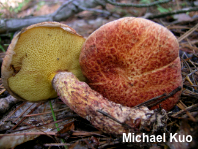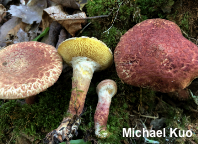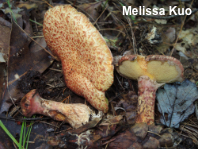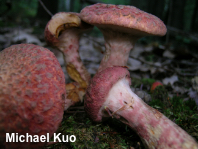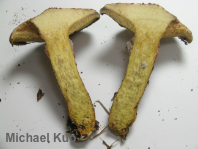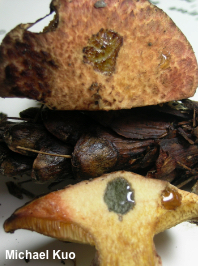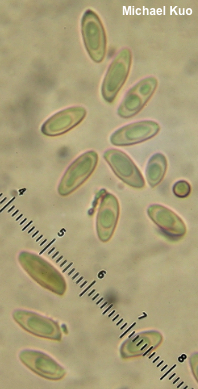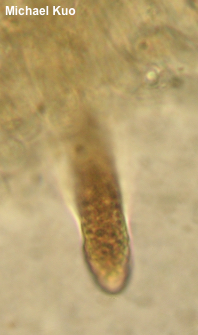| Major Groups > Boletes > Suillus > Suillus spraguei |

|
[ Basidiomycota > Boletales > Suillaceae > Suillus . . . ] Suillus spraguei by Michael Kuo, 9 December 2022 Whenever I launch into one of my "I hate Suillus" tirades, one of my mushrooming buddies reminds me that Suillus spraguei is a joy to find, because it's so beautiful. Its gorgeous rose-brick cap and stem colors contrast well with its pale yellow pore surface, and we find it under eastern white pine in northern Michigan every year, popping up frequently—and in unexpected places, adding a dash of color to a canvas of needle-duff browns. And: Suillus spraguei is one of the few Suillus mushrooms that doesn't suffer from whatever rare disease it is that makes their slime-o-factory glands overproduce. True enough—but it's still a Suillus. So I leave you to make your own judgments about this admittedly beautiful mushroom. I, meanwhile, will seek counseling for my problems with prejudice. You see, Doctor, as a child I was beaten with Suillus . . . Two very similar but phylogenetically distinct species occur under 5-needle pines in Asia; see Zhang et al. 2017 for details. Suillus pictus is a well-known synonym representing a nomenclatural mistake by C. H. Peck, who described Boletinus pictus as new in 1889, but cited Boletus spraguei as an earlier name for the mushroom—even argued that Boletus spraguei "does not seem to me to be specifically distinct" from his putatively new species. Description: Ecology: Mycorrhizal with eastern white pine; growing alone or gregariously; late summer and fall; originally described from "New England" (Berkeley & Curtis 1872); found throughout the natural range of the host tree; also found rarely under imported eastern white pine in Europe. The illustrated and described collections are from Kentucky and Michigan. Cap: 3–10 cm across; convex with an inrolled margin when young, becoming broadly convex to nearly flat; covered with large pinkish to brick-rose scruffies; with whitish partial veil tissue often hanging from the margin; dry; fading with age. Pore Surface: Covered with a whitish partial veil when young; yellow, becoming darker (brownish yellow) with age; sometimes running slightly down the stem; occasionally bruising reddish or brownish; pores angular, 1–5 mm across, vaguely radially arranged; tubes 4–8 mm deep. Stem: 4–10 cm long; 1–2 cm thick; equal or sometimes wider toward the base; without glandular dots, but shaggy with scruffies below the whitish to grayish ring; not bruising; basal mycelium white to yellow. Flesh: Yellow throughout; usually staining pinkish to reddish or brownish when sliced. Odor and Taste: Not distinctive. Chemical Reactions: Ammonia gray on cap surface; red on flesh. KOH dark gray on cap surface; blue, then slowly gray on flesh. Iron salts negative on cap surface; gray on flesh. Spore Print: Reddish brown. Microscopic Features: Spores 7–13 x 2.5–4 µm; boletoid-fusiform; smooth; dull yellowish in KOH. Basidia 25–28 x 4–6 µm; subclavate; 4-sterigmate. Cystidia in gelatinized bundles, often poorly defined individually; 25–60 x 5–10; cylindric to fusiform; thin-walled; smooth; hyaline to brown in KOH. Pileipellis an ixocutis of elements 2–7.5 µm wide, smooth, hyaline to yellow in KOH. REFERENCES: (M. J. Berkeley & M. A. Curtis, 1872) K. E. O. Kuntze, 1898. (Frost, 1874; Peck, 1889; Coker & Beers, 1943; Singer, 1945; Smith & Thiers, 1964; Snell & Dick, 1970; Smith & Thiers, 1971; Grund & Harrison, 1976; Smith, Smith & Weber, 1981; Weber & Smith, 1985; Arora, 1986; Phillips, 1991/2005; Lincoff, 1992; Both, 1993; Barron, 1999; Bessette, Roody & Bessette, 2000; Roody, 2003; McNeil, 2006; Miller & Miller, 2006; Kuo, 2007; Klofac, 2013; Kuo & Methven, 2014; Nguyen et al., 2016; Baroni, 2017; Woehrel & Light, 2017; Zhang et al., 2017; Elliott & Stephenson, 2018; Noordeloos, 2018; Sturgeon, 2018; McKnight et al., 2021.) Herb. Kuo 09019525, 09150711. This site contains no information about the edibility or toxicity of mushrooms. |
© MushroomExpert.Com |
|
Cite this page as: Kuo, M. (2022, December). Suillus spraguei. Retrieved from the MushroomExpert.Com Web site: http://www.mushroomexpert.com/suillus_spraguei.html |
